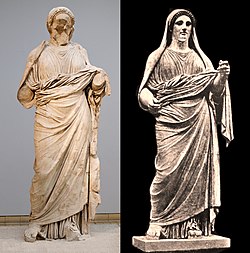
Back أرتميسيا الثانية من كاريا Arabic Artemisia II Breton Artemísia II de Cària Catalan Artemisia II. German Αρτεμισία Β΄ της Καρίας Greek Artemisia II de Caria Spanish Artemisia II.a Kariakoa Basque آرتمیس دوم Persian Artemisia II Finnish Artémise II French
| Artemisia II | |
|---|---|
 Original and reconstitution of the statue traditionally identified as Artemisia, from the Mausoleum at Halicarnassus, now in the British Museum. | |
| Satrap of Caria | |
| In office | 353–351 BCE |
| Predecessor | Mausolus |
| Successor | Idrieus |
| Born | c. 395 BCE. |
| Died | c. 351 BCE. |
| Consort | Mausolus |
| House | Hecatomnids |
| Father | Hecatomnus |
| Mother | unknown |
| Religion | Greek polytheism |
| Hecatomnid dynasty (Dynasts of Caria) | ||||||||||||||||||
|---|---|---|---|---|---|---|---|---|---|---|---|---|---|---|---|---|---|---|
|
||||||||||||||||||
Artemisia II of Caria (Greek: Ἀρτεμισία; died 351 BC[1]) was a naval strategist, commander and the sister (and later spouse) and the successor of Mausolus, ruler of Caria. Mausolus was a satrap of the Achaemenid Empire, yet enjoyed the status of king or dynast of the Hecatomnid dynasty. After the death of her brother/husband, Artemisia reigned for two years, from 353 to 351 BCE. Her ascension to the throne prompted a revolt in some of the island and coastal cities under her command due to their objection to a female ruler.[2]: 27 Her administration was conducted on the same principles as that of her husband; in particular, she supported the oligarchical party on the island of Rhodes.[3]
Because of Artemisia's grief for her brother-husband, and the extravagant and bizarre forms it took, she became to later ages "a lasting example of chaste widowhood and of the purest and rarest kind of love", in the words of Giovanni Boccaccio.[4] In art, she was usually shown in the process of consuming his ashes, mixed in a drink.
- ^ Fabre-Serris, Jacqueline; Keith, Alison (2015-12-15). Women and War in Antiquity. JHU Press. p. 235. ISBN 978-1-4214-1763-9.
- ^ Pennington, Reina (2003). Amazons to Fighter Pilots: A biographical dictionary of military women. Westport, CT: Greenwood Press. pp. 27–28. ISBN 0313327076.
- ^ Cite error: The named reference
diod_16.36_45_demwas invoked but never defined (see the help page). - ^ Boccaccio, Giovanni (2003). "Chapter 57". De mulieribus claris [On Famous Women]. Translated by Brown, Virginia. Harvard University Press. pp. 115–118. ISBN 0-674-01130-9. ISBN 9780674011304